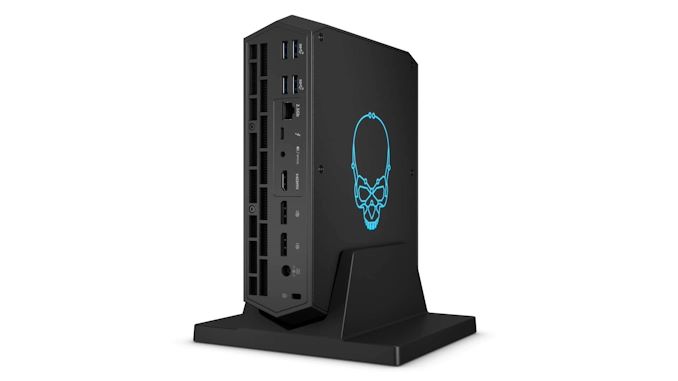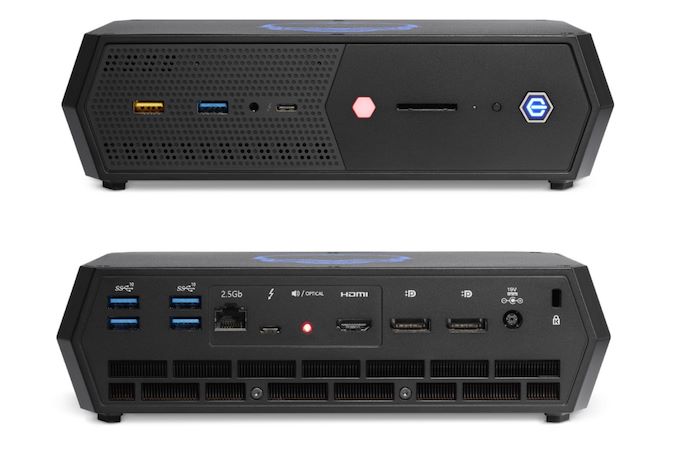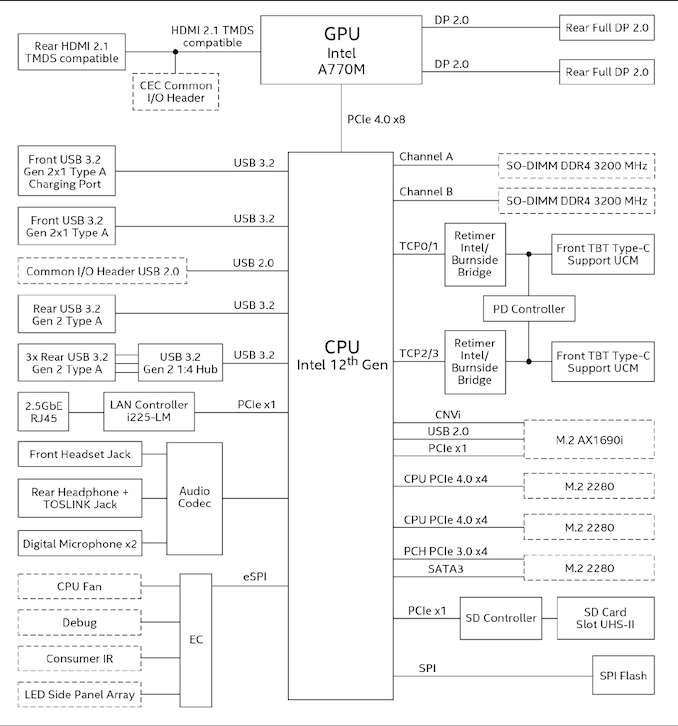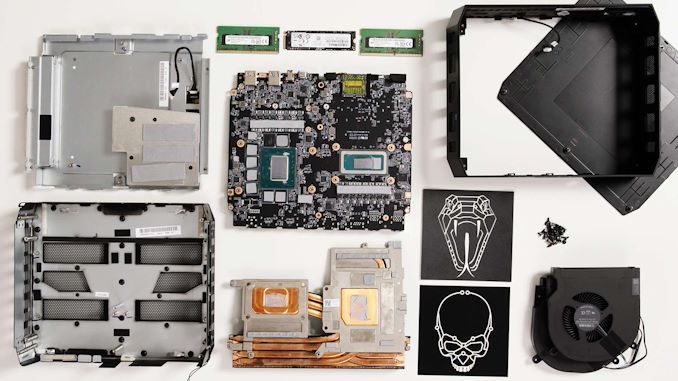Intel Announces Serpent Canyon: Alder Lake and Arc Amalgamate in NUC12 Enthusiast
by Ganesh T S on September 22, 2022 7:00 AM EST- Posted in
- Systems
- Intel
- NUC
- Alder Lake-H
- Arc

Intel officially unveiled the final member of their Alder Lake-based NUC12 family earlier this week. The NUC12 Enthusiast (like the three previous Enthusiast NUCs) caters to the gaming / creators market looking for a small form-factor machine with a discrete GPU.
As a refresher, Intel created the NUC Enthusiast category back in 2016 with the introduction of the Skull Canyon NUC (NUC6i7KYK). With a 4" x 5" motherboard, it had a slightly larger footprint compared to the traditional NUCs. However, the increased size allowed the incorporation of a 45W TDP processor with increased graphics flex. The second generation Hades Canyon moved to a slightly larger board (5.5" x 8"), while retaining the industrial design of the Skull Canyon NUC. It used the Kaby Lake-G processors with a Kaby Lake processor and an AMD GPU packaged together (with a total TDP budget between 65W and 100W). The NUC11 Enthusiast (Phantom Canyon) went for a more traditional gaming notebook-type architecture with a Tiger Lake-U Core i7-1165G7 and a NVIDIA RTX 2060 laptop GPU.
The NUC12 Enthusiast retains a similar architecture. The key difference lies in the fact that this is first NUC to utilize Intel's Arc discrete GPU. The specifications of the GPU are much more powerful than the NVIDIA RTX2060, and this has resulted in a redesign of the cooling solution as well as the chassis dimensions compared to the NUC11 Enthusiast.
Similar to the Phantom Canyon family, Serpent Canyon will also come in two varieties - a barebones version, and another with a 1TB SSD / 16GB of DDR4-3200 RAM / Windows 11 Home pre-installed. The SKUs utilize the Intel Core i7-12700H notebook processor and the Intel Arc A770M discrete GPU with 16GB of VRAM.
The NUC12 Enthusiast sports a rich set of I/Os. There are two Thunderbolt 4 ports (one in the front and one in the rear) that also carry the display output from the Intel Iris Xe Graphics in the Core i7-12700H. Two USB 3.2 Gen 2 Type-A ports and a SDXC UHS-II slot, along with an audio jack and a quad-microphone array round out the front panel. On the rear, we have an audio output jack (supporting TOSLINK), a single 2.5 Gbps LAN port, four USB 3.2 Gen 2 Type-A ports (with a hub chip behind), and the display outputs (1x HDMI 2.1 4Kp60 and 2x Display Port 2.0 (1.4 certified)) from the Intel Arc A770M.
The table below compares the specifications of the flagships in the last three generations of Enthusiast NUCs.
| Intel Enthusiast NUCs | ||||
| Model | Serpent Canyon (NUC12SNKi72) |
Phantom Canyon (NUC11PHKi7C) |
Hades Canyon (NUC8i7HVK) |
|
| CPU | Intel Core i7-12700H Alder Lake, 6P + 8E / 20T 4.7 GHz (P) / 3.5 GHz (E) 45W TDP (Up to 115W) |
Intel Core i7-1165G7 Tiger Lake-U, 4C/8T 2.8 - 4.7 GHz 28W TDP |
Intel Core i7-8809G Kaby Lake, 4C/8T 3.1 - 4.2 GHz 100W Package TDP |
|
| GPU | Intel® Intel Arc A770M 16GB GDDR6 @ 1.65 GHz (Discrete) | NVIDIA GeForce RTX 2060 6GB GDDR6 (N18E-G1-B Notebook Class 115W) @ 1.285 GHz (Discrete) Intel® Iris® Xe Graphics (96EU) @ 1.3 GHz (Integrated / On-Die) |
Radeon RX Vega M GH 4GB HBM2 @ 1.19 GHz (Discrete / On-Package) Intel® HD Graphics 630 @ 1.1 GHz (Integrated / On-Die) |
|
| Memory | 2x DDR4-3200 SODIMMs 1.2V, 64GB max. |
2x DDR4-2400+ SODIMMs 1.2V, 32GB max. |
||
| Motherboard | 7" x 8"(Custom) | 5.5" x 8" (Custom) | ||
| Storage | 2x M.2 22x80 (key M) PCIe 4.0 x4 NVMe SSD (CPU-attached) 1x M.2 22x80 (key M) SATA3 or PCIe 3.0 x4 NVMe SSD (via PCH) |
1x M.2 22x80/110 (key M) PCIe 3.0 x4 NVMe/AHCI SSD 1x M.2 2280 (key M) SATA3 or PCIe 3.0 x4 NVMe/AHCI SSD |
2x M.2 22x42/80 (key M) SATA3 or PCIe 3.0 x4 NVMe/AHCI SSD | |
| I/O Ports | 2x Thunderbolt 4 Fast-Charging (front + rear) 1x USB 3.2 Gen 2 Type-A (front) 1x USB 3.2 Gen 2 Type-A Fast-Charging (front) 4x USB 3.2 Gen 2 Type-A (rear) 1x SDXC UHS-II Card Slot (front) CIR (front) 1x SATA III Power + Data Internal Header 2x USB 2.0 Internal Header |
2x Thunderbolt 3 (rear) 4x USB 3.2 Gen 1 Type-A (rear) 1x USB 3.2 Gen 2 Type-A (front) 1x USB 3.2 Gen 2 Type-C (front) 1x USB 3.2 Gen 1 Type-A Fast-Charging (front) 1x SDXC UHS-I Card Slot (front) CIR (front) 1x SATA III Power + Data Internal Header 2x USB 2.0 Internal Header |
||
| Networking | Intel Killer Wi-Fi 6E AX1690i (2x2 802.11ax Wi-Fi inc. 6 GHz + Bluetooth 5.2 module) 1 × 2.5 GbE ports (Intel I225-LM) |
Intel Wi-Fi 6 AX201 (2x2 802.11ax Wi-Fi + Bluetooth 5.1 module) 1 × 2.5 GbE port (Intel I225-LM) |
Intel Dual Band Wireless-AC 8265 (2x2 802.11ac Wi-Fi + Bluetooth 4.2 module) 2 × GbE ports (Intel I219-LM + Intel I210-AT) |
|
| Display Outputs | 2x DP 2.0 (1.4 certified) (via Thunderbolt 4 Type-C, iGPU) 1x HDMI 2.1 (up to 4Kp60) (rear, dGPU) 2x DP 2.0 (1.4 certified, dGPU) |
2x DP 1.4a (via Thunderbolt 4 Type-C ports, iGPU Display Pipe) 1x mini-DP 1.4a (rear, dGPU, up to 8Kp60, MST) 1x HDMI 2.0b (rear, dGPU, up to 4Kp60) |
1x HDMI 2.0a (front, dGPU) 1x HDMI 2.0a (rear, dGPU) 2x mini-DP 1.3 (rear, dGPU) 2x DP 1.3 (via Thunderbolt 3 Type-C ports, dGPU) |
|
| Audio | 7.1 digital (over HDMI and DisplayPort) L+R+mic (front) L+R+TOSLINK (rear) |
|||
| Audio Codec | Realtek ALC274 | Realtek ALC700 | ||
| Enclosure | Metal and plastic Kensington lock with base security |
|||
| Power Supply | 330W (19V @ 16.9A) Adapter | 230W (19V @ 12.1A) Adapter | ||
| Dimensions | 230mm x 180mm x 60mm / 2.5L | 221mm x 142mm x 42mm / 1.3L | 221mm x 142mm x 39mm / 1.2L | |
| Miscellaneous Features | Vertical stand included | Vertical stand and VESA mount included | VESA mount included | |
| Lid with customizable RGB LED illumination behind user-replaceable mask CEC support for HDMI ports Front-panel CIR support for IR remotes Status LEDs in front panel Beam-forming microphone array 3-year warranty |
||||
The block diagram below gives some insights into the design of the system in relation to the I/O capabilities.
Despite the Arc A770M supporting a PCIe 4.0 x16 link to the host processor, the Serpent Canyon configuration keeps the connection at x8. Both PCIe 4.0 M.2 2280 slots are CPU-attached ones. The SD card slot is connected via a PCIe lane instead of USB - this should allow maximum possible performance for different SD cards. While the official specifications indicate that the slot is UHS-II, the technical product specifications document also indicates SD Express support. This depends on the exact SD controller being used in the board, and we have reached out to Intel for clarification. Three of the four Type-A ports in the rear are enabled by a 1:4 Gen 2 hub, which is not ideal in terms of bandwidth sharing. However, the availability of additional ports is always welcome. On the display front, the front Thunderbolt 4 port can support a display bandwidth of around 17 Gbps, while the rear port can support up to 35 Gbps. With multi-stream support on the Type-C port, the system can drive a total of six diifferent displays - five at 4Kp144 (DP/Alt-DP) and one at 4Kp60 (HDMI). Two 8Kp60 displays can also be driven using a multi-cable / -port solution.
Intel also provided a complete teardown picture along with the press release. The combined cooling solution for the CPU and dGPU with the thermal shroud and heat pipes is clearly seen. Whether this solution aids in / enables performance tuning via the Intel Deep Link Dynamic Power Share feature remains to be seen in hands-on evaluation.
Overall, the Serpent Canyon NUC is a huge step-up for Intel. Moving to a fully in-house solution for both the CPU and dGPU in a small form-factor portable machine will enable the company to gain a larger share of the gaming / creator systems / eSports total addressable market. Based on paper specifications, the level of integration and gaming prowess in the NUC12 Enthusiast should be well beyond what has traditionally been possible in this form factor. On the pricing front, the Mini-PC version with pre-installed OS will come in at $1350, while the barebones version can be purchased for $1180 later this month. These numbers roughly track the introductory pricing for previous-generation Enthusiast NUCs.
Source: Intel













12 Comments
View All Comments
Jorgp2 - Thursday, September 22, 2022 - link
I don't understand why we can't have desktop TB with displays fed off the iGPU like this system.meacupla - Thursday, September 22, 2022 - link
Probably because TB4 ports, or even USB-C with 100W PD/ alt mode DP, are considered "premium" features for desktop mobos.There are mobos with TB4 ports, like Asus ProArt mobos. They take a DP in signal to send through the TB4 output, so you can plug in desktop graphics.
PeachNCream - Thursday, September 22, 2022 - link
12 year old boys of the word - it's time to pick sides in favor of either a dumb snake or a dumb skull! Ready...Fight!!!In all seriousness, the hardware is interesting, though I wish Intel would finally eliminate the Killer branding and put that dumpster fire to rest where it should have gone ages ago when they were still trying to unload snake oil on the PC industry back in 2016. Longtime readers will recall Ian's inexplicable rush to defend what was obvious to anyone with networking knowledge as contemporary snake oil. It would need a nice thick layer of black tape to cover the childish case graphic and driver swap to address Killer garbo, but that aside, if you're willing to accept no long term upgrade path and sketchy Intel GPUs (which might not be a horrible idea given NV these days), it may not be a bad toy to play with if you feel inclined to blow your income on video games in today's economy.
hubick - Thursday, September 22, 2022 - link
Love the NUC's (had 2x Skull + 2x Hades, have NUC 9 Pro)!1) This is big enough now, they should have integrated the power supply like on the NUC 9 - I can only imagine the size of the brick for this.
2) Stop being cheap and just give us a 10G-BaseT port already.
3) My Surface Go 3 couldn't supply enough power for my external LaCie Rugged SSD Pro drive (Thunderbolt), so I was forced to switch to a USB 2x2 drive with integrated USB/DRAM controller (read: low power). This thing needs a USB 3.2 2x2 port! Though I'm guessing Intel would rather die before cannibalizing Thunderbolt and being compatible with the competition that ships on a lot of AMD systems (hopefully USB4 finally ships and changes this).
AdrianBc - Friday, September 23, 2022 - link
I have also liked a lot the Skull Canyon NUCs, I had three of those.The article does not describe adequately the Skull Canyon NUC. While its motherboard was larger than that of a standard 4x4 NUC, in order to allow two M.2 SSDs, its height was lowered by moving the cooler besides the motherboard (with a heat pipe), instead of above it.
So the Skull Canyon NUC had the same volume (0.7 L) as the taller variant of the 4x4 NUC, it was not bigger in volume.
While in the tall NUCs the extra volume is used for a 2.5" SSD, in the Skull Canyon NUC the extra volume was used for a bigger cooler, which allowed 45 W CPUs instead of the 28 W CPUs used in 4x4 NUCs.
The form factor of the Skull Canyon NUC was perfect for many professional applications and I am very sad that the Skull Canyon did not have any successor. The reason was that the team who designed the Skull Canyon was interested mostly in gaming, and a 45 W CPU is not good enough for gaming by itself.
Therefore the successors of Skull Canyon have been much larger gaming computers with an external GPU.
In the article there is also another statement that does not explain clearly a feature of Serpent Canyon. Even if the external GPU supports an up to 16x PCIe link, Serpent Canyon uses an 8x PCIe link.
That was not an option, all truly laptop CPUs, i.e. the Intel Alder Lake H series and also the AMD Rembrandt Ryzen 6000 series support only an 8x PCIe link for the GPU.
Only the Intel Alder Lake HX series, which are repackaged desktop CPUs, not CPUs designed for laptops, support a 16x PCie link for the GPU.
beginner99 - Friday, September 23, 2022 - link
The fact it's bigger than the one with an RTX 2600 and has higher power use, it doesn't bode well for ARC 770.thestryker - Friday, September 23, 2022 - link
The CPU being used has significantly higher power consumption and the video card has 16GB VRAM vs 6GB on the 2060. Both of these increase the baseline by quite a bit before the GPU power consumption even comes into play.TheinsanegamerN - Monday, September 26, 2022 - link
So that much larger heatsink was needed to cope with the 16gb of RAM in your mind?Flying Aardvark - Friday, October 21, 2022 - link
What kind of comment is that. No, the larger heatsink is there because these gaming NUCs never had great thermals. They're trying to fix that.meacupla - Saturday, September 24, 2022 - link
Phantom Canyon also had some issues with CPU getting very hot while gaming. Hopefully the chunky heatsink fixes it?